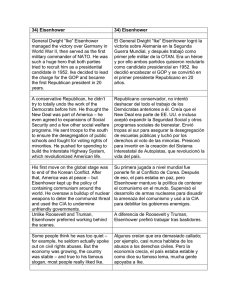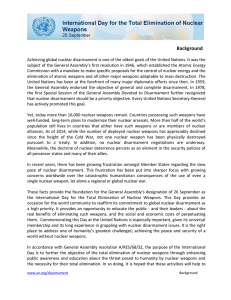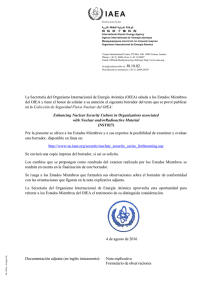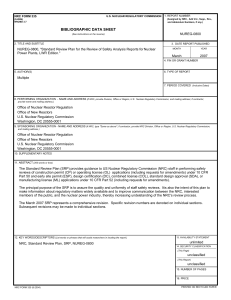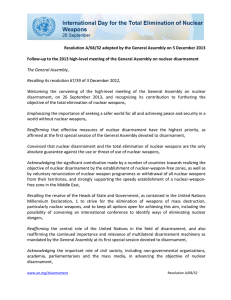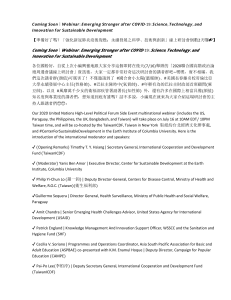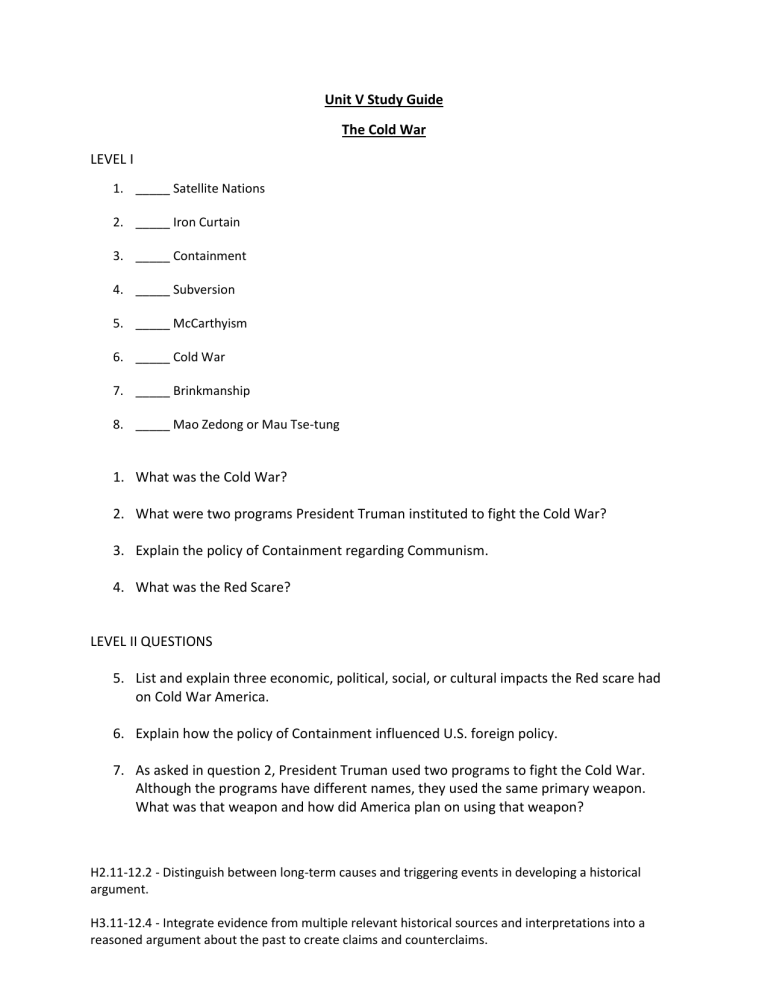
Unit V Study Guide The Cold War LEVEL I 1. _____ Satellite Nations 2. _____ Iron Curtain 3. _____ Containment 4. _____ Subversion 5. _____ McCarthyism 6. _____ Cold War 7. _____ Brinkmanship 8. _____ Mao Zedong or Mau Tse-tung 1. What was the Cold War? 2. What were two programs President Truman instituted to fight the Cold War? 3. Explain the policy of Containment regarding Communism. 4. What was the Red Scare? LEVEL II QUESTIONS 5. List and explain three economic, political, social, or cultural impacts the Red scare had on Cold War America. 6. Explain how the policy of Containment influenced U.S. foreign policy. 7. As asked in question 2, President Truman used two programs to fight the Cold War. Although the programs have different names, they used the same primary weapon. What was that weapon and how did America plan on using that weapon? H2.11-12.2 - Distinguish between long-term causes and triggering events in developing a historical argument. H3.11-12.4 - Integrate evidence from multiple relevant historical sources and interpretations into a reasoned argument about the past to create claims and counterclaims. LEVEL III 8. One of the ways America dealt with the Cold War at home was what became known as McCarthyism. Do you believe this to be an effective way to stop communism in America? Be sure to explain your response using examples of what occurred. LEVEL IV Evaluate if the threat of massive retaliation and brinksmanship to maintain peace was a good strategy. 1) State your opinion if they were a good strategy to maintain peace. 2) Be sure to give examples of how you feel it was a good strategy or bad strategy. 3) What were economic reasons for your choice. 4) What were political reasons for your choice. 5) What were social reasons for your choice. 6) You must also reference at least one of the graphics from questions 23 and 24 somewhere in your response as well as one statement in questions 25 and 26. The written source 25 and 26 is from is your textbook. Label your citation, "US Textbook" By the end of 1952, many Americans were ready for a change in leadership. The Cold War had much to do with that attitude. Many people believed that Truman’s foreign policy was not working. The Soviet Union had tested an atomic bomb and consolidated its hold on Eastern Europe. China had fallen to communism, and American troops were fighting in Korea. Tired of the criticism and uncertain he could win, Truman decided not to run again. The Democrats nominated Adlai Stevenson, governor of Illinois. The Republicans chose Dwight D. Eisenhower, the general who had organized the DDay invasion. Stevenson had little chance against a national hero who had helped win World War II. Americans wanted someone they could trust to lead the nation in the Cold War. Eisenhower won in a landslide. The Cold War shaped Eisenhower’s thinking from the moment he took office. He was convinced that the key to victory was not simply military might but also a strong economy. The United States had to show the world that the free enterprise system could produce a better society than communism. At the same time, economic prosperity would prevent Communists from gaining support in the United States and protect society from subversion. As a professional soldier, Eisenhower knew the costs associated with large-scale conventional war. Preparing for that kind of warfare, he believed, was too expensive. “We cannot defend the nation in a way which will exhaust our economy,” the president declared. Instead of maintaining a large and expensive army, the nation “must be prepared to use atomic weapons in all forms.” Nuclear weapons, he said, gave “more bang for the buck.” The Korean War had convinced Eisenhower that the United States could not contain communism by fighting a series of small wars. Such wars were unpopular and too expensive. Instead, wars had to be prevented in the first place. The best way to do that seemed to be to threaten to use nuclear weapons. This policy came to be called massive retaliation. Eisenhower's emphasis on nuclear weapons required new technology to deliver them. The president wanted to make sure that the United States could wage nuclear war even if the Soviets destroyed American bases in Europe or Asia. This required technology that would allow the U.S. to strike the USSR without needing bases overseas. At the same time, American forces had to be very difficult to destroy in one attack. If massive retaliation was to be an effective strategy, American nuclear weapons had to be deployed in a way that an enemy could not eliminate them all at once in a surprise attack. For this reason, the United States began to build what would later be referred to as the nuclear triad, a three part system made up of long-range bombers, land-based missiles, and missile-carrying submarines. H2.11-12.2 - Distinguish between long-term causes and triggering events in developing a historical argument. H3.11-12.4 - Integrate evidence from multiple relevant historical sources and interpretations into a reasoned argument about the past to create claims and counterclaims. In 1955, the U.S. Air Force unveiled the first part of the triad, the huge B-52 bomber which could fly across continents to drop nuclear bombs. The B-52 is still in use today. But because bombers could be shot down, Eisenhower also approved the development of intercontinental ballistic missiles (ICBMs) that could reach anywhere in the world in less than 30 minutes. The Atlas missile was the first American ICBM. It was also used to launch the first seven U.S. astronauts in the early 1960s. A modified version of the Atlas is still used today to launch satellites. For the third part of the triad, Eisenhower also began a program to build submarines capable of launching nuclear missiles from underwater. The Polaris submarine was the first submarine ever built to launch long-range missiles. The first Polaris submarine was deployed in 1960 and carried 16 nuclear missiles. The new policy enabled Eisenhower to cut military spending from around $50 billion to about $34 billion by reducing the size of the army, which was expensive to maintain. He then increased the U.S. nuclear arsenal from about 1,000 bombs in 1953 to about 18,000 bombs in 1961. One result of the decision to focus on massive retaliation was the emergence of a new arms race. The United States and the Soviet Union began to compete in the development of missiles and bombers, and steadily expanded the size and power of their nuclear arsenal. President Eisenhower’s willingness to threaten nuclear war to maintain peace worried some people. Critics called this brinkmanship—the willingness to go to the brink of war to force the other side to back down—and argued that it was too dangerous. During several crises, however, President Eisenhower felt compelled to threaten nuclear war. The Taiwan Crisis Shortly after the Korean War ended, a new crisis erupted in Asia. Although Communists had taken power in mainland China, Chinese Nationalists still controlled Taiwan and several small islands along China’s coast. In the fall of 1954, China threatened to seize two of the islands. Eisenhower saw Taiwan as part of the “antiCommunist barrier” in Asia that needed to be protected at all costs. When China began shelling the islands and announced that Taiwan would be liberated, Eisenhower asked Congress to authorize the use of force to defend Taiwan. He then warned that an attack on Taiwan would be resisted by U.S. naval forces and hinted that they would use nuclear weapons to stop an invasion. Soon afterward, China backed down. H2.11-12.2 - Distinguish between long-term causes and triggering events in developing a historical argument. H3.11-12.4 - Integrate evidence from multiple relevant historical sources and interpretations into a reasoned argument about the past to create claims and counterclaims. H2.11-12.2 - Distinguish between long-term causes and triggering events in developing a historical argument. H3.11-12.4 - Integrate evidence from multiple relevant historical sources and interpretations into a reasoned argument about the past to create claims and counterclaims.
